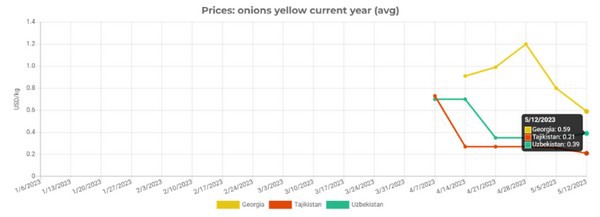According to EastFruit analysts, onions remain one of the most dynamic positions on the fruit and vegetable market, although, thanks to the arrival of new crop onions from Uzbekistan, Tajikistan, Kyrgyzstan and Kazakhstan, the hype in the market has somewhat subsided. However, there were some unexpected trends in the previous week that cannot be overlooked.
For the purpose of market analytics, we divided all countries into two categories: these where the market is already dominated by new crop onions, and those where the local harvest of new crop onions has not yet begun or where new onions do not yet dominate the market.
Tajikistan, Uzbekistan and Georgia fall into the first category and prices in these countries are consequently lower than in the second one.
The cheapest onions are now in Tajikistan. Over the week, wholesale prices for onions in this country decreased by another 19% and reached $0.21 per kg! Partly low onions prices are caused by the untransparent policies, as official announcement about onion export ban has not been made yet although market participants do know that onions could be exported. Thus, onions in Tajikistan are already cheaper than a year earlier. Interestingly, you can buy wholesale onions in Tajikistan five times cheaper than in Ukraine! Sounds like Tajik onions provide a good sourcing opportunity for an adventurous buyer even from the EU considering the price levels there!
Onion prices in Uzbekistan have unexpectedly grown during the past week, after two weeks of stability. Now high-quality onions in Uzbekistan are already sold in bulk at $0.39 per kg, and this is an all-time record price for onions for this period of time. Onions are now 44% higher than in 2022 at the same time and approximately twice the usual price for the first half of May.

By the way, according to market participants, during just the first 10 days of May 2023, Uzbekistan has exported 48 thousand tons of onions, which is almost 5 thousand tons of exports each day! Therefore, it is not at all surprising that onion prices remain high and continue to rise supported by the robust external demand. What really surprising is that in the neighboring Tajikistan onions are sold almost twice as cheap as in Uzbekistan.
Considering that frosts have damaged part of the winter onion crop in Uzbekistan, the situation on the market may turn out to be extremely interesting. Given the very rapid pace of onion exports, the country may again face a situation where the domestic market may become the main driver of price growth for onions.
For more information: east-fruit.com










